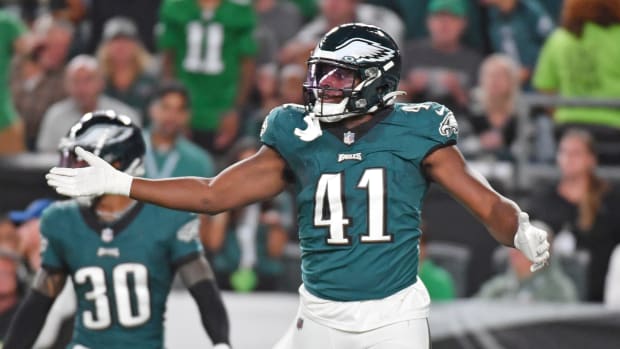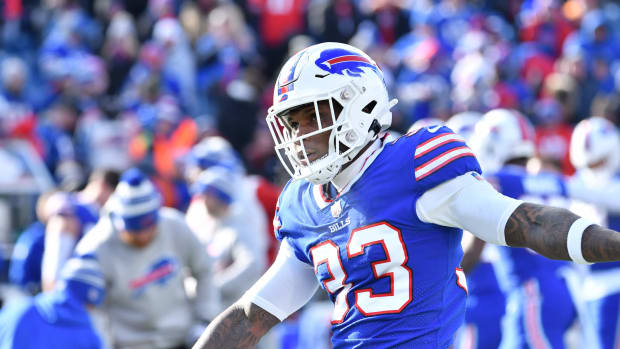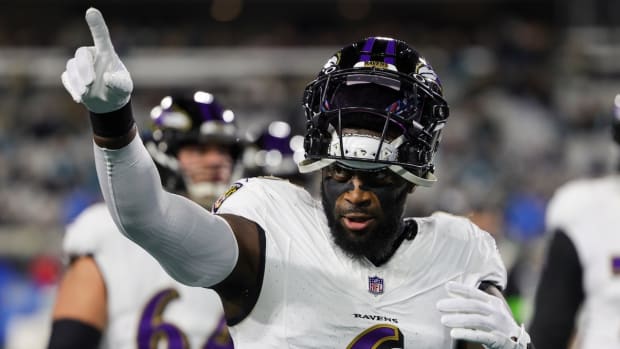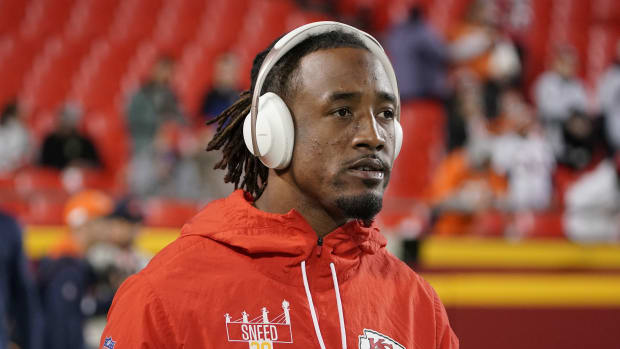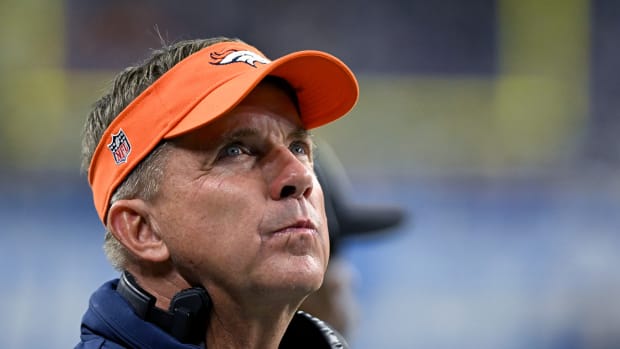
Conference Title Games: Gronk, Luck, Rodgers and Russell
Andy Lyons/Getty Images
Indianapolis Colts at New England Patriots
Patriots offense vs. Colts defense
When these teams met back in November, a guy named Jonas Gray ran the ball 37 times for the Patriots, racking up 201 yards. It wasn’t the production that stood out so much as how it was achieved. Thirty-two of Gray’s runs came behind a six-man offensive line. And 17 times, Gray ran “power” or “counter” to the strong side of those overloaded formations, behind a pulling blocker. In short, Bill Belichick and offensive coordinator Josh McDaniels felt they could simply line up and ram the ball down Indy’s throat. They were right.
Same Old Gronku2014Maybe Better
Will Belichick and McDaniels feel this way again? In the second half last week against Baltimore they totally abandoned a ground game that had generated a paltry 17 yards on 9 attempts in the first half (and one of these attempts was Tom Brady’s four-yard touchdown run, which came on a passing play).
The Colts run defense, meanwhile, bogged down against Denver’s six-man O-lines. Overall, it hasn’t been a great run defense since the Week 11 meeting, but as of late linebackers D’Qwell Jackson and Jerrell Freeman have played with impressive speed and recognition, thanks in part to a D-line that has Arthur Jones back and has seen improvements from nose tackle Josh Chapman (especially against interior zone run blocks).
Most likely, this game will come down to what the Patriots do through the air. Which means it comes down to whether the Colts can stop Rob Gronkowski. After being used primarily as a run-blocker in Week 11, the All-Pro tight end will be the fulcrum of a passing attack that will take place primarily between the numbers, away from outstanding corners Vontae Davis and Greg Toler.
In their man-based scheme, the Colts have typically matched safeties against tight ends this season. That’s what they did in Week 11, with Mike Adams and Sergio Brown taking on Gronk. That matchup was exposed in the second half of the game, and it will get exposed again this week, especially if LaRon Landry, who has fully replaced Brown in the lineup, is the cover guy. Landry’s stoutness as a box defender is matched only by his ineffectiveness as a back-peddler in space.
The Colts have an alternative solution for covering Gronk: Quarters coverage. It’s a hybrid scheme featuring man and zone principles. Coach Chuck Pagano and defensive coordinator Greg Manusky have gone to it regularly over the years. The only drawback is that it requires both safeties to line up about 12 yards off the ball, meaning there can’t be an eight-man box before the snap. The safeties do, however, have run-gap responsibilities on the outside and are in natural position to play downhill. As long as they don’t bite hard on play-action (something the uber-aggressive Landry is wont to do), it’s a viable defensive scheme.
Well-executed Quarters coverage can minimize Gronkowski, particularly down the seams where he’s most dangerous. Here’s a visual of how:
No coverage is flawless. (If one were, every defense would play it on every single snap.) Quarters can be defeated with intertwined route combinations that put multiple receivers in one defensive back’s zone. Or, more often, we see routes run vertically in the gray areas of those quarter zones, where it’s unclear whether the cornerback or the safety is responsible for that receiver. But conceptually, Quarters presents the most options for double-teaming a tight end or slot receiver (which Gronkowski often plays). And in order to beat the Patriots, you have to handle their tight end.
Andy Lyons/Getty Images
On the other side
Andrew Luck destroys opponents late in the down. Over the last two games the Colts offensive line has protected as well as any O-line we’ve seen this year, so there’s no reason to believe that Luck won’t be able to work late in the down Sunday night.
The MMQB Podcast
The Patriots, whose four-man pass rush is ineffective, should bring linebackers Jamie Collins and Dont'a Hightower on A-gap blitzes throughout the game. That might leave them susceptible to the check-downs that Luck has been so great at utilizing in these playoffs.
If you’re the Patriots defense who would you rather make beat you: Andrew Luck or Dan Herron?
Darrelle Revis shadowed Reggie Wayne in iso-man-coverage last time these teams met. That allowed the Pats to double T.Y. Hilton with Kyle Arrington and a safety. The guess here is this time around, Revis will take Hilton. Arrington, battling a hamstring, has not seen as much action lately, and Hilton has become more important to Indy’s offense—in part because the 36-year-old Wayne has become much less of a threat late in the season.
Belichick would be wise to go all-in with Revis and use his safeties as help defenders against the rest of Indy’s receivers. How those ancillary matchups play out will determine the winner on this side of the ball.
Colts-Patriots | Packers-Seahawks
For film study tweets throughout the week, follow @Andy_Benoit
Jonathan Ferrey/Getty Images
Green Bay Packers at Seattle Seahawks
Packers offense vs. Seahawks defense
When these teams met in the season opener, the Packers showed Richard Sherman unbridled respect, not throwing in his direction even once.
Rodgersu2019 Starr Moment
This was game-planned; the Packers consistently put their weakest receiver, Jarrett Boykin, across from Sherman and attacked elsewhere. It was the smartest approach an offense could take in deliberately cutting the field in half. The problem: Cutting the field in half is not a smart approach in and of itself. Especially against a defense as fast as Seattle’s.
In order to reach a second Super Bowl in five years, Mike McCarthy and Aaron Rodgers must be willing to attack anywhere on the field—including Sherman’s side. This doesn’t mean throwing to an isolated receiver there. Sherman in 1-on-1 situations is the most dangerous corner in football, particularly when he’s in off-coverage and able to keep an eye on the quarterback.
What the Packers can do is attack Sherman with a two-receiver combination that sends the slot receiver on a wheel route. This tactic would cater to Aaron Rodgers’s limited mobility. (Against Dallas his calf injury prohibited any out of pocket movement. That will likely be the case again this Sunday.)
Instead of explaining the mechanics of attacking Sherman, let’s illustrate.
The Packers are great at dictating mismatches through personnel location and formation variation. We see wideout Jordy Nelson line up out in the slot; tight ends Andrew Quarless and Richard Rodgers split out wide to eat up a cornerback and force slower inside defenders to handle wide receivers; and, more than ever lately, we see Randall Cobb coming out of the backfield to get matched against a linebacker or out-of-position cornerback.
Often out of these looks, the Packers run isolation routes, trusting that their gifted receivers can get open on their own against mismatched defenders. It’s not a bad bet, and the high volume of isolation routes enables Green Bay to operate out of spread formations, widening the defense and creating clearer passing lanes for the quick-striking Rodgers.
But the Seahawks defense is a whole other animal. Its linebackers and safeties are fast enough and smart enough to survive, and even win, in isolation against wide receivers. (Not every time, certainly, but enough to force a few punts over the course of a game.) This is in large part because Seattle’s corners dominate on the perimeter, effectively compressing the field inside. The way for an offense to combat this is to challenge those corners. And the way to challenge them is through specific play designs that give a cornerback conflicting assignments.
Jonathan Ferrey/Getty Images
On the other side of the ball….
Percy Harvin’s misdirections were a big factor in Seattle’s Week 1 game plan. Obviously, they’re now moot.
A Sunday With Richard Sherman
The closest Darrell Bevell’s offense comes to misdirection these days is moving the pocket for Russell Wilson—a tactic they don’t do as often as Wilson’s mobility suggests they could. Instead, Bevell lets Wilson create his own movement and extend plays into a sandlot mode, where he’s the best playmaker in the NFL.
The Packers have the resources to take this away. They’re a good slot-blitzing defense, they’re athletic inside with linebackers Sam Barrington and Clay Matthews, and safeties Morgan Burnett and Ha Ha Clinton-Dix. And, most importantly, they can play man coverage across the board, keeping all blitz designs at coordinator Dom Capers’ disposal.
Mixing all these together, Capers should trust his outside corners in man coverage and blitz the edges like crazy. Should Wilson break the blitz and get outside, Capers can spy with one of those athletic inside linebackers or safeties. Matthews would be the best bet, but the spy should be changed up throughout the game in order to complicate Seattle’s pass protections. (If the same player spies every time, the Seahawks can base their protections around him, making the blitzes easier to identify.)
The best part: edge blitzes are also a great way to combat a read-option rushing attack. Capers wouldn’t have to limit his blitzes to only passing situations. He could—and needs to—bring pressure on early downs.
Colts-Patriots | Packers-Seahawks
For film study tweets throughout the week, follow @Andy_Benoit
Follow The MMQB on Facebook, Twitter and Instagram.
[widget widget_name="SI Newsletter Widget”]













































